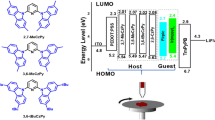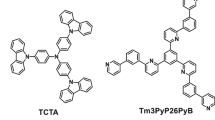Abstract
A series of new small molecules based on symmetric electron-acceptor of 1,3,4-oxadiazole moiety or its asymmetric isomer of 1,2,4-oxadiazole unit were successfully synthesized and applied to solution-processable blue phosphorescent organic light-emitting diodes for the first time, and their thermal, photophysical, electrochemical properties and density functional theory calculations were studied thoroughly. Due to the high triplet energy levels (ET, 2.82–2.85 eV), the energy from phosphorescent emitter of iridium(III) bis[(4,6-difluorophenyl)-pyridinate-N,C2′]picolinate (FIrpic) transfer to the host molecules could be effectively suppressed and thus assuring the emission of devices was all from FIrpic. In comparison with the para-mode conjugation in substitution of five-membered 1,3,4-oxadiazole in 134OXD, the meta-linkages of 1,2,4-isomer appending with two phenyl rings cause the worse conjugation degree and the electron delocalization as well as the lower electron-withdrawing ability for the other 1,2,4-oxadiazole-based materials. Noting that the solution-processed device based on 134OXD containing 1,3,4-oxadiazole units without extra vacuum thermal-deposited hole/exciton-blocking layer and electron-transporting layer showed the highest maximum current efficiency (CEmax) of 8.75 cd/A due to the excellent charge transporting ability of 134OXD, which far surpassed the similar devices based on other host materials containing 1,2,4-oxadiazole units. Moreover, the device based on 134OXD presented small efficiency roll-off with current efficiency (CE) of 6.26 cd/A at high brightness up to 100 cd/m2. This work demonstrates different nitrogen and oxygen atom orientations of the oxadiazole-based host materials produce major impact on the optoelectronic characteristics of the solution-processable devices.
Graphical Abstract







Similar content being viewed by others
References
Ma, Y.G., Zhang, H.Y., Shen, J.C., Che, C.M.: Electroluminescence from triplet metal-ligand charge-transfer excited state of transition metal complexes. Synth. Met. 94, 245 (1998)
Baldo, M.A., O’Brien, D.F., You, Y., Shoustikov, A., Sibley, S., Thompson, M.E., Forrest, S.R.: Highly efficient phosphorescent emission from organic electroluminescent devices. Nature 395, 151 (1998)
Sasabe, H., Kido, J.: Recent progress in phosphorescent organic light-emitting devices. Eur. J. Org. Chem. 2013, 7653 (2013)
Yang, X., Zhou, G., Wong, W.-Y.: Functionalization of phosphorescent emitters and their host materials by main-group elements for phosphorescent OLEDs. Chem. Soc. Rev. 44, 8484 (2015)
Jou, J.-H., Kumar, S., Agrawal, A., Li, T.-H., Sahoo, S.: Approaches for fabricating high efficiency organic light-emitting diodes. J. Mater. Chem. C 3, 2974 (2015)
Sasabe, H., Kido, J.: Development of high performance OLEDs for general lighting. J. Mater. Chem. C 1, 1699 (2013)
Tao, Y., Yang, C., Qin, J.: Organic host materials for phosphorescent organic light-emitting diodes. Chem. Soc. Rev. 40, 2943 (2011)
Xiao, L., Su, S.-J., Agata, Y., Lan, H., Kido, J.: Nearly 100% internal quantum efficiency in an organic blue-light electrophosphorescent device using a weak electron transporting material with a wide energy gap. Adv. Mater. 21, 1271 (2009)
Chang, Y.-L., Song, Y., Wang, Z., Helander, M.G., Qiu, J., Chai, L., Liu, Z., Scholes, G.D., Lu, Z.: Highly efficient warm white organic light-emitting diodes by triplet exciton conversion. Adv. Funct. Mater. 23, 705 (2013)
Lee, C.W., Lee, J.Y.: Above 30% external quantum efficiency in blue phosphorescent organic light-emitting diodes using pyrido[2,3-b]indole derivatives as host materials. Adv. Mater. 25, 5450 (2013)
Jou, J.-H., Lin, Y.-X., Peng, S.-H., Li, C.-J., Yang, Y.-M., Chin, C.-L., Shyue, J.-J., Sun, S.-S., Lee, M., Chen, C.-T., Liu, M.-C., Chen, C.-C., Chen, G.-Y., Wu, J.-H., Li, C.-H., Sung, C.-F., Lee, M.-J., Hu, J.-P.: Highly efficient yellow organic light emitting diode with a novel wet- and dry-process feasible iridium complex emitter. Adv. Funct. Mater. 24, 555 (2014)
Yook, K.S., Lee, J.Y.: Small molecule host materials for solution processed phosphorescent organic light-emitting diodes. Adv. Mater. 26, 4218 (2014)
Wu, H., Ying, L., Yang, W., Cao, Y.: Progress and perspective of polymer white light-emitting devices and materials. Chem. Soc. Rev. 38, 3391 (2009)
Wang, S., Wang, X., Yao, B., Zhang, B., Ding, J., Xie, Z., Wang, L.: Solution-processed phosphorescent organic light-emitting diodes with ultralow driving voltage and very high power efficiency. Sci. Rep. 5, 12487 (2015)
Ameen, S., Lee, S.B., Yoon, S.C., Lee, J., Lee, C.: Diphenylaminocarbazoles by 1,8-functionalization of carbazole: materials and application to phosphorescent organic light-emitting diodes. Dyes Pigments 124, 35 (2016)
Moon, B.-J., Yook, K.S., Lee, J.Y., Shin, S., Hwang, S.-H.: Synthesis, photophysical and electro-optical properties of bis-carbazolyl methane based host material for pure-blue phosphorescent OLED. J. Lumin. 132, 2557 (2012)
Jeong, S.H., Lee, J.Y.: Carbazolyldibenzofuran-type high-triplet-energy bipolar host material for blue phosphorescent organic light-emitting diodes. J. Lumin. 146, 333 (2014)
Ban, X., Jiang, W., Sun, K., Xie, X., Peng, L., Dong, H., Sun, Y., Huang, B., Duan, L., Qiu, Y., Appl, A.C.S.: Bipolar host with multielectron transport benzimidazole units for low operating voltage and high power efficiency solution-processed phosphorescent OLEDs. Mater. Interfaces 7, 7303 (2015)
Tao, Y., Guo, X., Hao, L., Chen, R., Li, H., Chen, Y., Zhang, X., Lai, W., Huang, W.: A solution-processed resonance host for highly efficient electrophosphorescent devices with extremely low efficiency roll-off. Adv. Mater. 27, 6939 (2015)
Jiang, W., Tang, J., Ban, X., Sun, Y., Duan, L., Qiu, Y.: Ideal bipolar host materials with bis-benzimidazole unit for highly efficient solution-processed green electrophosphorescent devices. Org. Lett. 16, 5346 (2014)
Liu, H., Bai, Q., Yao, L., Hu, D., Tang, X., Shen, F., Zhang, H., Gao, Y., Lu, P., Yang, B., Ma, Y.: Solution-processable hosts constructed by carbazole/po substituted tetraphenylsilanes for efficient blue electrophosphorescent devices. Adv. Funct. Mater. 24, 5881 (2014)
Gong, S., Fu, Q., Zeng, W., Zhong, C., Yang, C., Ma, D., Qin, J.: Solution-processed double-silicon-bridged oxadiazole/arylamine hosts for high-efficiency blue electrophosphorescence. Chem. Mater. 24, 3120 (2012)
Tao, Y., Wang, Q., Yang, C., Wang, Q., Zhang, Z., Zou, T., Qin, J., Ma, D.: A simple carbazole/oxadiazole hybrid molecule: an excellent bipolar host for green and red phosphorescent OLEDs. Angew. Chem. Int. Ed. 47, 8104 (2008)
Tao, Y., Wang, Q., Yang, C., Zhong, C., Zhang, K., Qin, J., Ma, D.: Tuning the optoelectronic properties of carbazole/oxadiazole hybrids through linkage modes: hosts for highly efficient green electrophosphorescence. Adv. Funct. Mater. 20, 304 (2010)
Deng, L., Li, J., Li, W.: Solution-processible small-molecular host materials for high-performance phosphorescent organic light-emitting diodes. Dyes Pigments 102, 150 (2014)
Yook, K.S., Lee, J.Y.: High quantum efficiency in solution processed blue phosphorescent organic light-emitting diodes based on an asymmetric benzothienopyridine host. J. Lumin. 153, 317 (2014)
Cheng, S.-H., Chou, S.-H., Hung, W.-Y., You, H.-W., Chen, Y.-M., Chaskar, A., Liu, Y.-H., Wong, K.-T.: Fine-tuning the balance between carbazole and oxadiazole units in bipolar hosts to realize highly efficient green PhOLEDs. Org. Electron. 14, 1086 (2013)
Chen, H.-F., Chi, L.-C., Hung, W.-Y., Chen, W.-J., Hwu, T.-Y., Chen, Y.-H., Chou, S.-H., Mondal, E., Liu, Y.-H., Wong, K.-T.: Carbazole and benzimidazole/oxadiazole hybrids as bipolar host materials for sky blue, green, and red PhOLEDs. Org. Electron. 13, 2671 (2012)
Mondal, E., Hung, W.-Y., Dai, H.-C., Wong, K.-T.: Fluorene-based asymmetric bipolar universal hosts for white organic light emitting devices. Adv. Funct. Mater. 23, 3096 (2013)
Huang, H., Wang, Y., Pan, B., Yang, X., Wang, L., Chen, J., Ma, D., Yang, C.: Simple bipolar hosts with high glass transition temperatures based on 1,8-disubstituted carbazole for efficient blue and green electrophosphorescent devices with “ideal” turn-on voltage. Chem. Eur. J. 19, 1828 (2013)
Hernández-Ainsa, S., Barberá, J., Marcos, M., Serrano, J.L.: Liquid crystalline ionic dendrimers containing luminescent oxadiazole moieties. Macromolecules 45, 1006 (2012)
Agneeswari, R., Tamilavan, V., Song, M., Kang, J.-W., Jin, S.-H., Hyun, M.H.: Synthesis of polymers containing 1,2,4-oxadiazole as an electron-acceptor moiety in their main chain and their solar cell applications. J. Polym. Sci. Pol. Chem. 51, 2131 (2013)
Li, Q., Cui, L.-S., Zhong, C., Yuan, X.-D., Dong, S.-C., Jiang, Z.-Q., Liao, L.-S.: Synthesis of new bipolar host materials based on 1,2,4-oxadiazole for blue phosphorescent OLEDs. Dyes Pigments 101, 142 (2014)
Li, Q., Cui, L.S., Zhong, C., Jiang, Z.Q., Liao, L.S.: Asymmetric design of bipolar host materials with novel 1,2,4-oxadiazole unit in blue phosphorescent device. Org. Lett. 16, 1622 (2014)
Gong, S., Zhong, C., Fu, Q., Ma, D., Qin, J., Yang, C.: Extension of molecular structure toward solution-processable hosts for efficient blue phosphorescent organic light-emitting diodes. J. Phys. Chem. C 117, 549 (2013)
Su, S.-J., Cai, C., Kido, J.: RGB phosphorescent organic light-emitting diodes by using host materials with heterocyclic cores: effect of nitrogen atom orientations. Chem. Mater. 23, 274 (2011)
Li, Y.F., Cao, Y., Gao, J., Wang, D.L., Yu, G., Heeger, A.J.: Electrochemical properties of luminescent polymers and polymer light-emitting electrochemical cells. Synth. Met. 99, 243 (1999)
Acknowledgements
This work was financially supported by National Natural Science Foundation of China (21572094, 51073057 and 91233116), the Ministry of Science and Technology (2014DFA52030 and 2015CB655003), the Ministry of Education (NCET-11-0159), the Department of Education of Zhejiang Province (Y201533100), and Lishui University (15JZ08). The authors are grateful to Yifan Li and Prof. Chuluo Yang for their help in low temperature phosphorescence measurements.
Author information
Authors and Affiliations
Corresponding authors
Electronic supplementary material
Below is the link to the electronic supplementary material.
Rights and permissions
About this article
Cite this article
Ye, H., Wu, H., Chen, L. et al. Synthesis, Properties, Calculations and Applications of Small Molecular Host Materials Containing Oxadiazole Units with Different Nitrogen and Oxygen Atom Orientations for Solution-Processable Blue Phosphorescent OLEDs. Electron. Mater. Lett. 14, 89–100 (2018). https://doi.org/10.1007/s13391-018-0011-8
Received:
Accepted:
Published:
Issue Date:
DOI: https://doi.org/10.1007/s13391-018-0011-8




